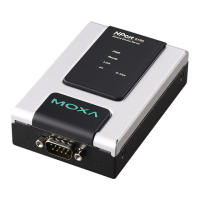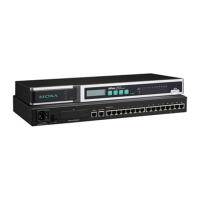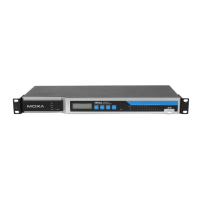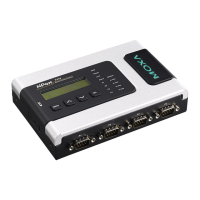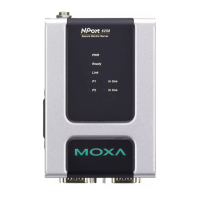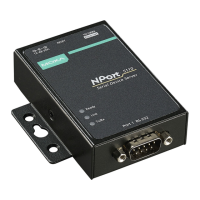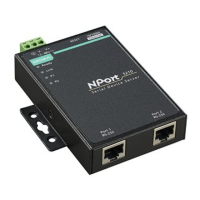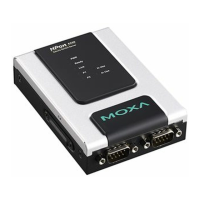
Do you have a question about the Moxa Technologies NPORT 6150 and is the answer not in the manual?
| Display | - |
|---|---|
| Baud rate | 921.6 Kbit/s |
| Data bits | 5, 6, 7, 8 |
| Isolation | 1.5 kV |
| Stop bits | 1, 1.5, 2 |
| RS-232 signals | CTS, DCD, DSR, DTR, GND, RTS, Rx, Tx |
| RS-422 signals | GND, RxD+, RxD-, TxD+, TxD- |
| RS-485 signals | Data+, Data-, GND, RxD+, RxD-, TxD+, TxD- |
| Flow Control type | RTS/CTS, XON/XOFF |
| Flow control support | Yes |
| Serial interface type | RS-232, RS-422, RS-485 |
| Serial ports quantity | 1 |
| Ethernet LAN data rates | 10, 100 Mbit/s |
| Surge protection voltage | 0.5 kV |
| Mean time between failures (MTBF) | 2097705 h |
| Cabling technology | 10/100Base-T(X) |
| USB 2.0 ports quantity | 0 |
| Built-in processor | No |
| Input voltage | 12 - 48 V |
| Power consumption | 285 mA |
| Power source type | DC |
| Storage temperature (T-T) | -40 - 75 °C |
| Maximum operating altitude | 2000 m |
| Operating temperature (T-T) | 0 - 55 °C |
| Operating relative humidity (H-H) | 5 - 95 % |
| Supported network protocols | ICMP, IPv4/v6, TCP, UDP, DHCP, BOOTP, Telnet, DNS, SNMP V1/V2c/V3, HTTP, SMTP, ARP, PPPoE |
| Security algorithms | AES, DES, SSH, SSL/TLS |
| Product color | Black, Blue, Grey |
| Housing material | Metal |
| Sustainability certificates | RoHS |
| Weight | 700 g |
|---|---|
| Dimensions (WxDxH) | 67 x 100.4 x 29 mm |
General overview of the NPort 6000 series.
Lists the items included in the NPort 6000 package.
Lists the key features of the NPort 6000 series.
Compares the main differences between NPort 6000 models.
Details the technical specifications for various NPort 6000 models.
Diagrams showing the physical layout of NPort 6150, 6250, and 6450.
Instructions for mounting NPort devices using various methods.
Steps and guidelines for connecting NPort 6000 hardware.
Explains the choice between static and dynamic IP configurations.
States the default IP address of the NPort 6000 device.
Details methods for initial IP address configuration.
Explains the NPort 6000's network capabilities and serial port functions.
Describes how to configure serial ports for different operation modes.
Covers modes like Real COM and RFC2217 for device control.
Details TCP Server, TCP Client, and UDP modes for network communication.
Explains how to remove RS-232 distance limitations.
Enables NPort 6000 for legacy systems without TCP/IP.
Covers ASCII, BIN, and SSH modes for terminal access.
Explains Reverse Telnet and Reverse SSH modes.
Details NPort 6000's printer mode for banking and stock exchange services.
Describes NPort 6000's dial-in/dial-out capabilities.
Explains how to disable NPort 6000 serial ports.
Steps to configure browser settings for web console access.
Explains how to navigate the NPort 6000 web console interface.
Settings related to network configuration, including basic and advanced options.
Settings for various network expansion modules.
How to implement Ethernet redundancy using protocols like STP/RSTP.
Explanation of Spanning Tree Protocol and Rapid Spanning Tree Protocol.
How to set up Moxa's proprietary Turbo Ring protocol for network redundancy.
How to configure individual serial port operation modes and parameters.
Covers modes like Real COM and RFC2217 for device control.
Details TCP Server, TCP Client, and UDP modes for network communication.
How to remove RS-232 distance limitations using two NPorts.
Enables NPort 6000 for legacy systems without TCP/IP.
Covers ASCII, BIN, and SSH modes for terminal access.
Explains Reverse Telnet and Reverse SSH modes.
Details NPort 6000's printer mode for banking and stock exchange services.
Describes NPort 6000's dial-in/dial-out capabilities.
Explains how to disable NPort 6000 serial ports.
Configuration of serial port parameters like baud rate, data bits, and parity.
Settings for port buffering to prevent data loss and enable logging.
Configuration for dial-in/dial-out modem settings.
Settings for SSL/TLS and SSH cipher priorities.
Stores user accounts for terminal/reverse terminal access authentication.
Allows setting a custom welcome message for users.
Configuration of server name, location, and time settings.
Controls access to serial ports based on IP address filtering.
Assigns Host Names to Host IP Addresses for easier console entry.
Procedure for upgrading the NPort 6000 firmware.
Options for backing up and restoring device configurations.
Importing and managing SSL/TLS certificates for secure communication.
Manages user accounts, groups, and permissions for device access.
Configuration for the SNMP agent, including community strings and access control.
Settings for RADIUS and TACACS+ server integration for authentication.
Configuration of console access methods like HTTP, Telnet, and SSH.
Resets all NPort 6000 settings to factory defaults.
Customizes network events to be logged locally or remotely.
Configures the NPort 6000 to send logs to a remote server.
Monitors serial and system status, including network connections.
Configures automatic notifications for system, network, and serial events.
Basic common settings including Ping test.
Tests Ethernet connection by pinging an IP address.
Procedure to change the device's login password.
Saves submitted configuration changes to the NPort's flash memory.
Options to restart the system or specific ports.
Terminates the current user session.
Manages COM port mapping for NPort serial ports in Windows.
Locates NPort servers on the network and allows IP address changes.
Instructions for installing and mapping drivers for Linux systems.
Steps to install and configure fixed TTY drivers for UNIX systems.
Shows pinout diagrams for NPort 6150/6250/6450 and NPort 6600.
Illustrates wiring diagrams for Ethernet and serial cables.
How to set up RFC-2217 mode for virtual COM port mapping.
Lists port numbers that may cause network issues if used.
Lists supported SNMP MIB-II variables for NPort 6000.
Details RFC1317 RS-232 like groups for SNMP.
Provides the Moxa-NP6000-MIB definition.
Explains RADIUS protocol and its client/server architecture.
Steps to configure NPort 6000 with RADIUS server IP and port.
Instructions for setting up FreeRADIUS server for UNIX hosts.
Steps to configure RADIUS authentication on Windows NT.
Configuration steps for RADIUS on Windows 2000.
Configuration steps for IAS/RADIUS on Windows 2003.
